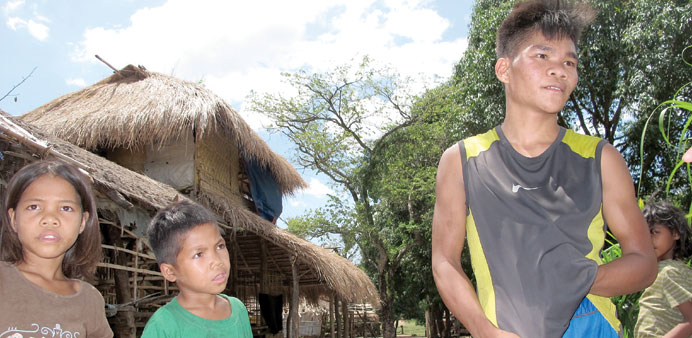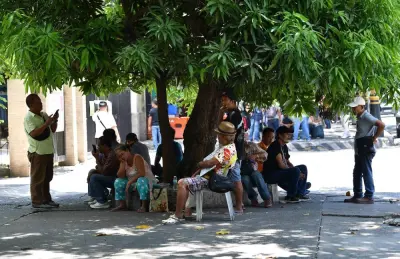UNCERTAIN: Marlon Cabre, 18, right, in Mayba on Mindoro Island in the Philippines. He plans to make a living as a farm labourer and dreams of going to college, but does not want to live his life anywhere other than in Mangyan country.
By Christiane Oelrich
Of course he knows big city life, says 15-year-old Sigonda Seth. By that he means Sablayan, a settlement of a couple of thousand people which can only be reached from Sigonda’s village after an hour’s walk through the mountains.
It’s clean there, the roads are covered with asphalt, there are shops and plenty going on. But he says firmly that he’ll never live there. Sigonda belongs to the Mangyan people and lives with his family in a bamboo hut in Mayba on the Philippine island of Mindoro.
Worldwide, indigenous people face encroachment from governments, economic forces and majority societies. But there are often no easy answers to the dilemma between preserving traditional values and bringing people such benefits of modernity as good health.
For example, on Mindoro there’s a plan to build a nickel mine. The prospect is forcing the Mangyan to make difficult decisions.
The Mangyan are several thousand strong and live in the mountains. Many are nomadic and move around, depending on the season and planting cycle. Some clans reject all contact with the outside world. Others grow cassava, sweet potatoes and bananas and put out feelers to the world outside their villages.
Lonito Dassa, a tribal elder, says at a village meeting in Mayba that he’d like to try out a mobile phone. He has seen young people play games on one and take photos. There’s no wireless coverage in Mayba, so that’s all they are good for hereabouts.
A proper road out would not be a bad thing, says another elder, Simon Rubin, and would make things easier for the children who have to carry the bananas.
But all are agreed on one thing: “We are humble and contented. We want to live as we have always done.” One of the elders is even dressed in a loincloth.
They’ve all heard of the nickel mine project. Norwegian firm Intex wants to build a mine and the Mangyan are worried. They’ve heard that mines destroy mountains, pollute rivers and leave the land unusable.
“This forest is our life,” says Dasa as the others nod. “It’s a school for our children, it’s our pharmacy. We must preserve it for our children and their children.”
Intex presents itself as an engaged partner to the natives. “We offer free healthcare, we’ve installed water pipes, 2,900 families are now getting clean drinking water. We’ve built two schools with fixtures, we’ve donated material,” says Joselito Bacani, president of Intex in the Philippines.
Around 1,000 Mangyan have taken training courses in subjects such as farming methods, environmental protection, bookkeeping, fish processing, composting and plant medicine. The nickel mine is predicted to create 8,000 jobs.
“But have we any chance?” asks Rubin. “Most of us can’t even drive a car.”
According to the United Nations, around 5 per cent of the world population is made up of indigenous people, some 370 million people in 90 countries who speak 4,000 languages. Seventy per cent of them live in Asia. Most live in groups as a minority among other peoples and have their own distinct languages and traditions.
The UN has a forum for indigenous peoples which calls for measures to preserve extinct languages and the return of artefacts taken away as curiosities by explorers in the 18th and 19th centuries. It says projects like the Intex mine should only go ahead with the consent of the indigenous peoples affected by it.
The Council of Mangyan tribes (Paksakami) has decided on opposition to the mine. Chairman Nestor Liboro says: “This land belongs to God, we are only the governors and we must pass it on intact to the next generation.”
“We don’t understand a lot about mines, we rely on what Paksakami says,” says Artemio Enano, a village headman from the Banban settlement.
But his colleague Mario Daguhoy disagrees: “I once stayed on an island that had a mine. People were doing a lot better, they had a real town, the school even had two floors.” This comment sparks admiration, but even so most people at the village meeting are opposed to the mine.
“Our life is good here,” says Lani Nala, 31, a mother of three children. She has her youngest, 3-year-old Joyjoy, with her. “I hope my children will stay in the village.”
Dodoy Sabong, 34, has eight children. After the meeting when everyone has gone he says: “If my eldest wants to work in a mine I’d have nothing against it. Here in the village we’re terribly poor.”
Nestor acknowledges that there are tensions: “Sometimes the generations clash. Often the young favour such projects. Today, young people are more individualistic. They voice objections to their elders, they come with new ideas and ask: If things stay as they are, where will we get our mobile phones?” There are no easy answers to questions like that.
The Philippine government has strengthened the rights of the country’s indigenous people. They can now get land title for the regions where they have lived for thousands of years. The process is difficult — boundaries are unclear and there can be disputes about land with valuable natural resources. However, several Mangyan tribes now have the land ownership and so have an official say in what happens in their region.
Although they might describe it as idyllic, life is not perfect for the people of Mayba. The children’s charity Plan International points to the lack of awareness of children’s rights. Children are sometimes beaten at home and at school and in some cases schools are so far away that they don’t even go to them. Their parents, who themselves never received an education, work in the fields and have little time to help them. Many children are malnourished.
Plan International sends teachers from village to village who teach according to the children’s needs. It promotes children’s councils in the villages to show that children need respect. In Mayba, Sigonda is the council spokesman.
The big questions — whether villages need electricity or not, how that would be paid for, whether young people need more education so they can earn money in town, whether the nickel mine would be good or bad — are something the Mangyan must answer for themselves.
Marlon Cabre, 18, plays basketball with his friends. He dreams of college but what he would do afterwards he’s unsure of. Urban life doesn’t appeal to him: “Here I was born, here I belong.”
“Wealth, what is that?” asks village elder Dasa. “No land in the world can be as rich as the territory that our ancestors have lived on for thousands of years.” —dpa



